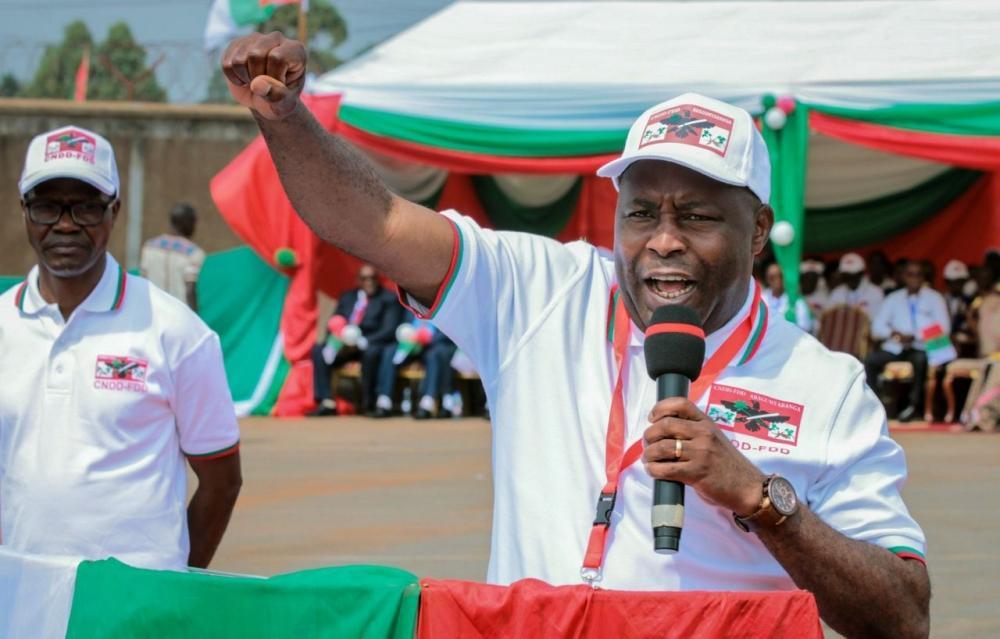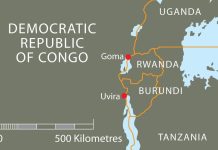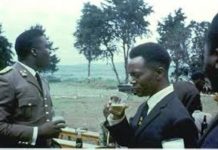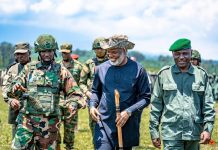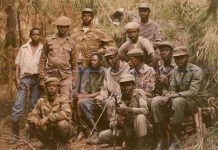Patient Kwizera
Africa-Press – Rwanda. The military junta in Burundi, represented politically by the CNDD-FDD party – symbolized by the eagle wielding a machete – has been implicated in numerous deaths from the civil war era (1993-2004) to the present.
This regime more recently began to distribute bladed weapons (machetes, nailed clubs, head-breaking sticks) and Kalashnikovs to Imbonerakure militiamen and to the CNDD-FDD radicals and former guerrillas, to be sent to DR Congo alongside the Burundian national army. Their mission is to support Congolese President Felix Tshisekedi’s coalition forces in fighting the M23/AFC rebellion in the east of the country. The M23/AFC rebellion is defending the rights and safety of the Congolese Tutsi who are under threat of genocide.
The reason why Burundi is in DR Congo is based on primitive politics. Historically, the first president of Burundi after independence, Michel Micombero (November 28, 1966 – November 1, 1976) inherited a backward country and a society divided on ethnic lines (Hutu/Tutsi) created by Belgian colonialists. Regrettably, this division persists today, with an extremist junta of FDD guerrilla soldiers at the helm. These militias sowed terror and massacred civilians from 1993 to 2004 but never succeeded in defeating the loyal soldiers of Pierre Buyoya. The interesting thing is that the Arusha peace accords, promoted by the former president of Tanzania, Julius Nyerere, and then, following Nyerere’s death, by former South African president Nelson Mandela, allowed the FDD militia to come to power without having won the civil war and without having confronted the popular will at the ballot box.
The workings of the CNDD-FDD regime in Burundi, which one must examine through its state structures, revolve around the Head of State, the Minister of State in charge of Security, the Director General of National Intelligence, the CNDD/FDD Secretary General, and the Chief of Staff of the Presidency’s Civil Cabinet, Police Affairs, and Military Affairs. As far as I know, and this is important, as Chief of Military Affairs, the current leader of Burundi, Évariste Ndayishimiye or General Neva, oversees Imbonerakure, the CNDD-FDD militia which was responsible for much of the violence against civilians during former President Pierre Nkurunziza’s tenure. Under these parallel chains of command, orders ran through a network of loyalties dating back to Burundi’s ethnically driven civil war (1993-2004).
The CNDD-FDD’s purpose in closing the border with Rwanda and sending soldiers and militiamen to DR Congo is no longer to be hidden. Developments on the ground show that the aim is to help Tshisekedi drive out everyone that resembles the Tutsi, from the Great Lakes region.
The CNDD-FDD regime managed to leverage the historic anachronistic ideological alliance between Hutu and Bantu extremists in Tanzania and South Africa, prompting them to join Tshisekedi in the ongoing campaign against Congolese Tutsi. In the Great Lakes region, since the 1950s, the Tutsi suffered a series of unprecedented ethnic cleansings that have forced them to opt for self-defence, hence the origins of the M23 in DR Congo.
This is not the first time CNDD-FDD has been involved in a campaign of ethnic cleansing within DR Congo. In 1998, when a full-scale war broke out in DR Congo, the FDD quickly moved in to support the genocidal Interahamwe and Hutu Power brigades that perpetrated the 1994 genocide against the Tutsi in Rwanda before running to the then Zaire.
The policy that allowed the CNDD-FDD regime to be part of an ethnic cleansing campaign against Congolese Tutsi was birthed long ago. In 1972, a seed of hatred was planted, initially by colonialists. But it was there after nurtured by Burundians themselves. Colonial agents who first arrived in the Great Lakes region viewed the local populations through a lens steeped in the racist ideologies of their era, such as Gobineau’s theory of racial inequality. They imposed a hierarchical classification of the populations into categories ranging from quasi-European to primitive, and from naive to deceptive. This classification quickly led to the infamous Hamitic theory, which erroneously branded the Tutsi as Ethiopian migrants who had usurped the indigenous Bantu populations, despite “Bantu” being merely a linguistic grouping and the Tutsi themselves being Bantu.
In reality, the historical thread between Rwanda’s racial Hutu Power regime of 30 years ago and the current one in Burundi is dictated by identical visions of a racial society. From a party that intended to be the spokesperson of the oppressed Hutu masses, the CNDD followed the same fate as the Rwandan party of Juvenal Habyarimana, MRND. Both parties progressively transformed into dictatorial parties formed by mafia interests intent on reckless plunder of national wealth to the detriment of people.
Both MRND (from the 1960s to the 1990s) and CNDD (from 2005 to the present) masked their true intentions with rhetoric against the Tutsi conceived from the 1957 political text: Note sur l’aspect social du problème racial indigène au Rwanda, known as the Bahutu Manifesto, the Mein Kampf, with an African ethnic flavour, from which originated the ideology of ethnic social redemption: Hutu Power. In Rwanda, this ideology had its disastrous epilogue in 1994. In Burundi, there were several attempts at genocide in the sixties, seventies, and nineties, till today.
Since then, CNDD-FDD has always defended the racial ideology of Hutu Power more out of political opportunism than from ideological conviction.
As occurred in 1994, in Rwanda, with the extremists of the Habyarimana regime, CNDD-FDD also employed racial supremacy, intended to avenge the Hutu masses over the alleged dictatorships of the Tutsi, in the manner of a deceptive lure presented to the semi-illiterate Hutu peasant masses.
The CNDD-FDD regime continues to promote propaganda which takes up the most extreme and violent clichés of Rwandan Hutu Power’s racial hatred which led to the 1994 genocide against the Tutsi. The Burundian Tutsi are deprived of a national identity. They are Ethiopians and should go back to where they came from. They are described as dogs that “feed on the blood of the Hutu”.
This propaganda is spread by the CNDD-FDD regime, Imbonerakure, the official media, the Truth and Reconciliation Commission led by a Hutu Power idealogue, Pierre Claver Ndayicariye, who is very close to the genocidal forces from Rwanda, FDLR, an extremist journalist named Kenny Claude Nduwimana, and by the Burundian Goebells, Willy Nyamitwe.
Others include a racial extremist who hates the Tutsi and is the current president of the National Assembly, Gelase Ndabirabe. Since Ndabirabe could one day be elected as interim president, given his current position, and the situation could get worse in Burundi.
Despite all, in reality, the Hutu Power rhetoric of the CNDD-FDD regime as a bulwark against “Tutsi tyranny” has long since crumbled, despite the regime’s efforts to propose this ideological reading to justify closing the border with Rwanda and sending soldiers to eastern DR Congo. Majority of the participants in the popular 2015 protests and the failed coup were Hutu.
The November 2015 calls for genocide (Kora Kora) launched by the regime in evident crisis were not welcomed by the urban or rural Hutu population.
As French philosopher and historian Michel Foucault argues in his texts on bio-politics, where politics ends, we move on to bloody conflicts on an ethnic basis. Fortunately, the failure to impose the Hutu Power ideology as a single main idea in Burundi, as happened in Juvenal Habyarimana’s Rwanda, significantly shows that General Neva’s policy will end badly.
Today, Burundi is sinking into an economic spiral of hyperinflation, lack of liquidity, unemployment, unpaid wages, and poverty, which is the backdrop of the primitive politics that reign supreme in the country.
Source: The New Times
For More News And Analysis About Rwanda Follow Africa-Press

